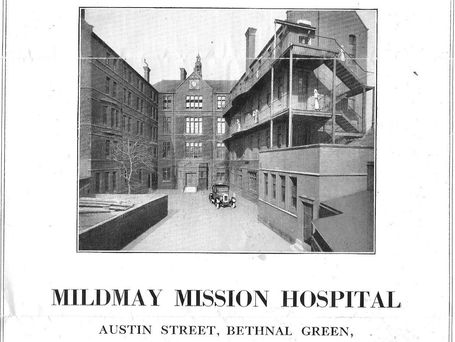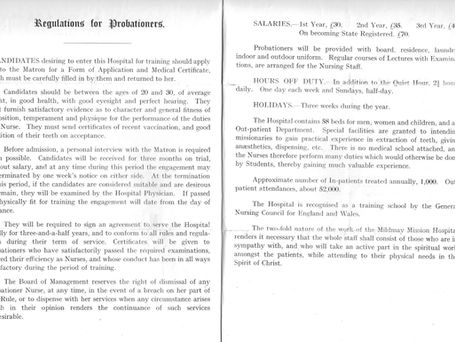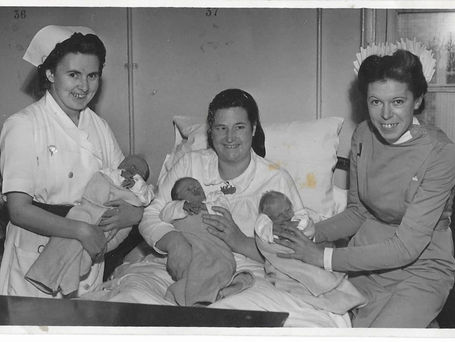Margaret Kerin: A life of nursing, 1915-1990

Margaret Kerin was born on 27 May 1915, near the city of Longford in the midlands of Ireland.
She was the second daughter of Thomas and Elizabeth Kerin, a Protestant couple of Co. Cork and Co. Offaly respectively. They worked in service, Elizabeth as a house servant and Thomas as a gardener.
The family moved to Clara, Co. Offaly and lived in tied accommodation in the grounds of house belonging to the Goodbody family, prominent Quakers. Margaret and her sister attended the Protestant National School. During their time in Clara, two more sisters were born. In the early 1920s, the Civil War made the situation for Protestants in Clara very difficult and soon after her youngest sister’s birth in January 1922, the family moved to the comparative safety of Rathowen in Co. Westmeath where her father again worked as a gardener. Here the family remained until 1930 when Margaret was 15.
In 1930, the family moved near Skerries, Co. Dublin. Her elder sister soon left, going into service in Kells, Co.Meath and Margaret attended Skerries Technical School for a year. She wanted to train as a nurse but this was not possible.
According to Joseph Robins’ book about the history of nurse training in Ireland, the Council of Ireland had been formed in 1922 which led to setting standards for recruitment, training and supervision. General Training Hospitals required a relatively large fee for student nurses which meant nursing became a middle-class occupation, effectively barring the working classes. Even if fees could have been found, religious orders and boards of management who ran the hospitals ensured that those selected were from ‘good’ families likely to maintain the high standards of the profession. Margaret’s only option was to follow in the footsteps of her elder sister and mother and go into service. She took work in Dublin as a children’s nanny for approximately ten years.
The family moved to Ashford in Co. Wicklow in 1938. Her elder sister had moved from Kells and had taken a position in Portmarnock north of Dublin and her younger sister had moved nearby to Malahide. The Second World War brought employment opportunities to many Irish people. Although Southern Ireland was a neutral country and many Irish citizens opposed supporting Britain in the war on the side of its old enemy, a significant number of Irishmen volunteered in the British Armed Services and women travelled north to join the Auxiliary Territorial Service (ATS) or were recruited as student nurses. Margaret’s younger sisters joined the ATS in the North of Ireland in 1941 and in 1942 and her elder sister married in February 1942.
Despite initially resistance from her father, later in 1942 Margaret went to Britain to train as a nurse at the Mildmay Mission Hospital in Bethnal Green, London. It is probable that Margaret wanted to escape her life in service and do something more exciting like her sisters, but the chief motivation would have been that nurse training was free in the United Kingdom.
Margaret was 27 when she arrived in London. The move to Britain must have been both frightening and exciting. London had suffered the ‘blitz’ between September 1940 and May 1841. The underground system continued to be used as a shelter from air raids. On 3 March the siren went off and people went to Bethnal Green underground station. Someone fell near the bottom of the steps which led to people being crushed and 173 people being killed. News of the disaster was suppressed for fear of encouraging the Germans and fear it would have a negative effect on public morale. However, staff in the Mildmay would clearly have been aware.
Although the Kerin family were scattered across Southern Ireland, Northern Ireland and England, they wrote to each other every week, letters going through the censor. Although many of the communications are mundane, some show an insight into what was happening around them.
Correspondence shows that Margaret was successful in passing the three-month trial period and completing her training. She travelled back to Ireland for both her younger sisters’ weddings in Belfast, travelling with her family from the south to the north of Ireland in 1945 and 1946.
In one letter, written in December 1943, she gives an account of Christmas at the hospital. The letter is addressed from the Mildmay Mission Hospital, Austin St, Bethnal Green, London E2 on 26th December 1943.
"…..we had a very happy Christmas here and a very jolly time. I will try and tell and tell you about it. We had early tea in bed on Xmas morning and our presents brought into us by four of the nurses, two dressed as Americans, two as British subjects in stars and stripes and in red, white and blue. They had a gramophone on a trolley which they played as they served tea.
We sang a carol on the middle landing at 6.45 am for the patients and then we went to breakfast. We were told to bring something to breakfast from a needle to a piano! When we went into the dining room there were two long tables, blue for the British and one for Americans. We sat at a table corresponding to what to what we brought to breakfast. As I brought a bag of nuts, I sat at the American table. We had a variety of food, some of the American dishes we did not attempt to taste! We had coffee at the American table and tea at the British one.
During breakfast the two doctors came in, one dressed as Father Christmas and the other as a Sister with bottle of medicine and everyone who got a present from Father Christmas got a dose!
I was working on the Men’s ward most of Xmas Day and all today. We had a lovely time there as the ward was full but no one very ill. The ward was decorated as a ship called the Victory. We had a gangway leading into the ward and all the life belts, flags, boats, barrels, ropes were hired for the occasion. I wish you could see it as it’s difficult to describe just how it looked, it was mostly done in red, white and blue and the centre table was rigged up as the Captain’s cabin.
The ship was bound for the Cape of Good Hope which was in big lettering across the ward. We wore sailor’s caps and badges so we had quite a lively time. The patients had turkey, plum pudding etc on Xmas Day, also a special tea.
We had a more or less ordinary dinner that day except we had mince pies as sweet. We had a lovely American tea in the sitting room at 4pm, up to forty of us, such a spread, chicken, ham, salad, celery, rolls and a lot of other cakes, trifle and crackers so we did very well indeed, it was all prepared by the four nurses. We also had a lovely supper that night and the table was prettily decorated. Xmas Day was a very full day otherwise I would have written to you but that evening after supper the four nurses had a play in the First Aid Post, ‘how the bible came to England’. It was very good and nearly all the nurses and staff and some outsiders were at it. We had hot and cold fruit drinks and a selection of eatables after that too so it was after 10pm before we broke up.
Today we had our Xmas dinner, we had pork instead of turkey, it was really nice and we had a lovely plum pudding with a lot of silver in it but I did not happen to get any. Then we had a special evening’s entertainment for the patients and their friends. We had tea for everyone and then we had carols with our lanterns when the lights were out. Everyone seemed to enjoy them very much, each ward had the same.
There was a Christmas Tree in the Women’s ward and Father Christmas gave everyone a small present. I had a soap bag. He also gave all the patients presents on Xmas morning. This evening after all the friends had gone we all played games etc with the patients, a good many of them were able to be up so they enjoyed it very much. We had some nice services in the ward during Christmas.
I did not get to church on Xmas Day but Sister Winifred took a nice service in the morning and spoke on Peace be still and Matron took the service this morning … I had about fourteen little presents from the nurses I am friendly with… I had several presents from patients in massage… we open up again in X-Ray and massage tomorrow… there is a party in out-patients on Saturday for the children… we are to sing carols in one of the shelters tomorrow night."
It is clear Margaret was very happy at the Mildmay. Her family became aware that she wanted to be a missionary. This was not really surprising considering the missionary foundation of the hospital. Although a member of the Church of Ireland, the style of worship would have been quite different from her previous experience in that it took a more evangelical stance towards Christianity. These religious teachings had a significant effect on Margaret for the remainder of her life. Her wish to be a missionary was thwarted when it was deemed that she was not strong enough to take on such a role. It can only be presumed that this assessment was made by medical staff at the hospital. Electoral rolls of 1946 show that although Margaret was living near the hospital, she had moved out of nurses accommodation.
It was probably at this point that she decided to train to be a midwife. She went to the North-West Middlesex Hospital and then returned to the Mildmay in 1947 to work. However, it would seem that she left the Mildmay, possibly due to changes related to it being taken over by the National Health Service in 1948.
By November 1947, she was employed at Hillingdon Hospital in West London as she was involved with the birth of triplets said to be the heaviest to be born there. A notice in the Uxbridge and West Drayton Gazette on the 28th November 1947 stated: "The adults were all smiles but not so the West Drayton triplets who wondered what the excitement was all about when the picture was taken at Hillingdon Hospital. On the left is Nurse Kerin holding Ronald, then comes the proud mother, Mrs Hook, with Rodney and last Sister McCarthy with Raymond Philip."
It is not clear why Margaret decided to return to Ireland unlike so many Irish nurses after the war, particularly as Hillingdon Hospital was near to where her younger sisters were now settled. She was living in lodgings and possibly missed the camaraderie of her work colleagues. Also, maybe she was influenced by the fact that her father had died in 1946 and she felt she should spend more time with her mother. She returned to Ireland in 1949 and took a post at the Dublin Medical Mission in Chancery Lane next to the Four Courts, in the centre of Dublin.
The Medical Mission had been established in 1891 to work amongst the poor and was used as a training facility for sending missionaries to Africa. The Mission was able to offer accommodation and a small salary. Accommodation was an important factor as there was no family home to which she could return. Her mother had to leave the tied accommodation in which she had lived with her husband in Ashford, Co. Wicklow and go to live with her eldest daughter and family in Malahide. Margaret had to supplement her small income from the Medical Mission by working at night in Adelaide Hospital and later at the Rotunda Maternity Hospital.
Family anecdotal evidence reveals that Margaret continued to be involved in evangelical Christian movements when she returned to Dublin. She attended services at the Medical Mission, the YMCA and Salvation Army in Dublin. She made friends with staff as well as a number of benefactors of the Medical Mission. During her time there, Margaret made weekly visits to her mother, sister and nephews in Malahide and made regular visits back to England, often accompanied by a friend, to see her two sisters and their families. Margaret spent much of her spare time going to various retreat centres in Northern Ireland and the Republic of Ireland, often accompanied by her mother.
Other than nursing duties at the Mission, Margaret was involved with activities with people from the local area such as Christmas parties and outings.
During the mid-1960s, changes took place at the Dublin Medical Mission and it amalgamated with the Dublin City Mission founded in 1828 and the Dublin Mission founded in 1953, to become the Dublin Christian Mission in 1965. Margaret lost both her job and her home. It is probably that, through contacts at the Mission, she was offered the post of Matron at the Magdalene Asylum. It was the original Asylum of its kind that had been founded in 1765 by Arabella Denny of Tralee Castle, Co. Kerry. She was a Protestant Irish philanthropist who had made significant reforms to the Dublin Foundling Hospital at the end of the 18th century. She had come to know many of the desperate unmarried women who found themselves pregnant and had opened a home in Lower Leeson Street as a sanctuary for ‘penitent’ Protestant women. It was run by the Church of Ireland, solely for Protestants.
The home moved to a large Victorian house in leafy Eglinton Road, Donnybrook, Dublin and Margaret took over as matron from 15th December 1965.
Little did she know at the time that she was distantly related to Arabella Denny through her great-grandfather who had been a Protestant clergyman in Ardfert, Co Kerry. The home was small, having at most, ten young women. During Margaret’s time, the number of young women coming to the home to have their babies fell, partly due to the decrease in the number of Protestants in Ireland. Also, the number of Protestant young women who had come from Britain fell also due to more rapidly changing attitudes there towards unmarried mothers in the 1970s.
Margaret retired from the home in February 1985. Again, she faced the challenge of accommodation but she was fortunate to be accepted for a flatlet in Tritonville, Sandymount, a sheltered accommodation complex run by a Presbyterian organisation. She spent many happy years there, going on holiday to see friends and relatives including travelling to Bermuda to see the brother of a good friend. She took up a number of creative hobbies such as painting, pressing flowers and making greeting cards. She was a caring and generous sister and aunt.
Margaret died of an infection that she contracted in hospital following breaking her leg. She was buried at St Andrew’s Church of Ireland in Malahide, the place where her older sister and nephews lived and which she had known for over 50 years.













